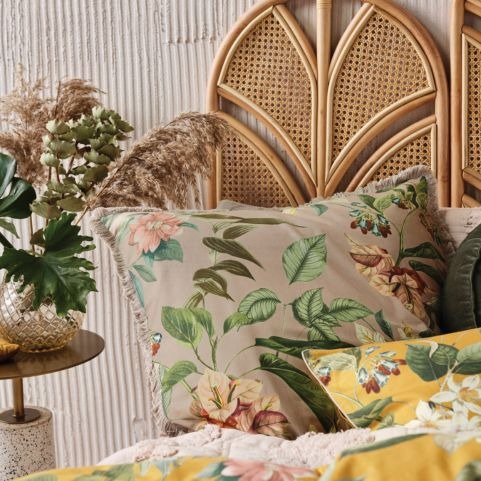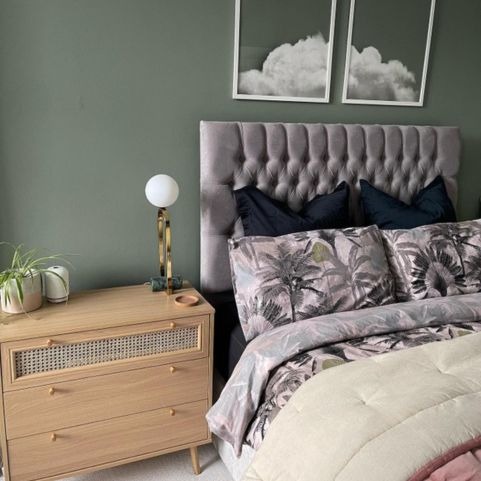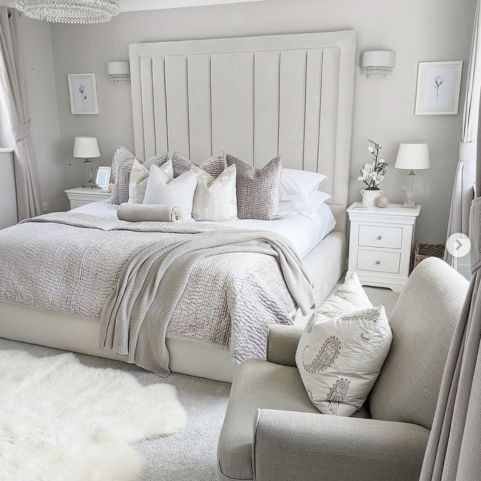we're taking you under the covers of these bumper bedroom accessories.
Let’s face it – sometimes, two pillows are simply not enough. While our sleeping preferences can be just as individual as ourselves, one thing we can all agree on is that a flat, underdressed bed isn’t the most inviting sight to return home to after a long day. When it comes to our sleep, we deserve something better – something impressive. Something lavish and layered-up, rich and irresistible, that lets you know with just one glance that the dreamiest night’s slumber awaits, and all you’ve got to do is jump in.
Enter, the much discussed pillow sham. Maybe you’ve heard of it, or perhaps you’ve stumbled across one of its many revolving stage names. Pillow sham; Euro sham; bed sham; continental sham – or even just ‘sham’, once you get to know her – the never-ending aliases can get a bit confusing. The bewilderment doesn’t stop at names, either, and much mystique surrounds the nature and function of shams. From where they should be placed, to whether they should be slept on, to what they even are in the first place.
So, leave your slippers at the door and tuck in tight – we’re diving deep on all things pillow shams.
A pillow sham is basically just a large, highly decorative pillowcase that’s designed to be used for style rather than sleeping. While decorative pillows come in all shapes and sizes, shams are usually sized 50x65cm and above, and are placed at the very back of a bed’s pillow arrangement. Due to their larger size, shams are great for providing bulky back support when chilling throughout the day, and bring a stylish illusion of height and dimension that’ll instantly elevate your bed’s look. They also do a great job of covering up headboards if yours isn’t fitting the vibe (or if you haven’t got one at all – just pop on a few pillow shams, and no one has to know).
"Shams are all about style and decoration" says Suzi, furn.'s design manager and bedding expert. "While pillowcase covers have an important functional role - protecting the inner pad - shams are pure statement pieces, sometimes used behind pillowcases or over as decoration on a made bed".
Most of our shams measure 65x65cm, and are designed to fit over standard sleeping pillows. You might have come across the term ‘euro sham’ or ‘continental sham’, and while these are commonly used interchangeably with ‘sham’, there is a slight difference between the two. A continental or Euro sham technically refers to a sham which is designed to fit over a Euro pillow, which are large square pillows typically measuring around 65x65cm.
You might be wondering where the term ‘sham’ even comes from, and if you are – boy, have we got a story for you. When shams first began popping up during the 18th century, they were manufactured as ‘false front’ covers that could be placed over standard sleeping pillows. These false covers were purely decorative, and the only intention was to make plain, tired pillows look a whole lot more impressive. Thus came the name ‘sham’, which you might recognise from its more commonly known definition as “a trick that deludes” or something of “cheap falseness”, per Merriam-Webster.com.
While there’s nothing cheap or false about pillow shams – and that definition might make you feel like your pillow’s going to start whispering Machiavellian riddles in your ear through the night – it’s an interesting piece of background that sums up the whole idea behind pillow shams: making your bed look better with a big, ornamental pillowcase.
So, we’ve covered what makes a sham a sham – but how exactly do they differ from your standard pillowcase? As we’ve learned already, one of the main characteristics of shams is that they’re purely decorative accents that aren’t meant to be slept on. This is one of the main differences that separates shams from sleeping pillows. There’s a subtle hint in the name, and if you’re sharp you might have caught it – but sleeping pillows are, in fact, designed to be slept on.
While nobody’s going to stop you from resting your head on a sham instead of a pillow once bedtime rolls around, they often feature embroidery, jacquard weaves and other ornate textures that might not feel amazing against skin. Shams also commonly have flanging, cording or other loose fabric around their border, which can become bunched up and uncomfortable as you sleep. Sleeping pillows, on the other hand, are generally made from bed linen fabric, and their main purpose is to protect your pillow pad from dust, body oils and other impurities.
"Another common difference between shams and regular pillowcases is size" Suzi points out. "Shams and Euro pillowcases tend to be larger than the average pillowcase, and can be used as well as or instead of them - however, they still come in a variety of styles and sizes".
Most of the shams in our collection measure 65x65cm, giving them a sophisticated square look that brings both order and variation to a bed arrangement. While you’ve got the option of either a housewife or larger Oxford border when choosing your standard pillowcase, both have the same internal dimensions of 50x70cm.
If you want to get really technical, another subtle – but important – difference between shams and pillowcases lies in their openings. Most standard pillowcases have an opening at one end to allow easy removal and replacement of inner pads. Many of these openings can’t be sealed or closed at all, resulting in a small section of excess fabric which hangs from one side. As shams are designed for decoration, sporting an appendage of baggy fabric isn’t exactly ideal, so they’re commonly sealed with a zip or secure envelope closure. A sham’s opening is usually found on the back, leaving the front and sides free to glitter, gleam and steal the show in your bedroom scheme.
While pillow shams and scatter cushions are both primarily decorative, that’s pretty much where the similarities end. Cushions are typically the smallest accents you’ll find adorning a bed, and can come in a variety of sizes and shapes – from round cushions to cylindrical bolster cushions, to playful novelty shapes that let creativity take the wheel. While they undoubtedly exist somewhere in the creative landscape of interior design, unconventionally shaped shams aren’t a common sighting. They’re more often large, square and uniform – lending structure, style and size to any bed arrangement.
"Shams and European pillowcases can work really well behind standard pillowcases" Suzi suggests. "Create a layered look with ease by mixing up the sizes, or use a different colour sham behind for more contrast".
Like shams, the focus with scatter cushions is on aesthetics and design. There are endless different patterns to explore, from flourishing florals to alluring animals, eye-catching geometric motifs and more. The only real difference is that scatter cushions usually sit somewhere in the 40x40cm to 50x50cm size range, and are only meant to provide colour, texture and shape – not size. These cushions will be going right at the front of your arrangement, while your sizeable shams act as a foundation – providing support and sitting pretty at the very back.
header image credit: @athomewithcharl













